Previous - Slovenian coins before euro
Slovenian euro coins - catalog with values
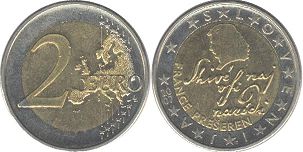
2 euro 2007 (2007- )
bi-metallic - nickel-brass/copper-nickel
circulation coinage
2 EURO
SLOVENIJA / FRANCE PRESEREN / SHIVE NAJ VSI NARODI / 2007
Coin value ~ 3-5 USD
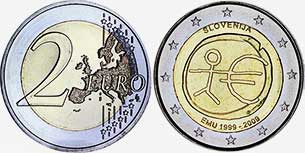
2 euro 2009
bi-metallic - nickel-brass/copper-nickel
commemorative coin
10th Anniversary of Economic and Monetary Union
2 EURO
SLOVENIJA / ЕMU 1999-2009
Coin value ~ 3-5 USD
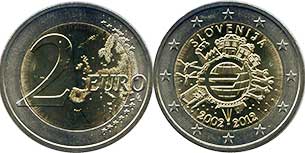
2 euro 2012
bi-metallic - nickel-brass/copper-nickel
commemorative coin
10th anniversary of the introduction of euro cash
2 EURO
SLOVENIJA / 2002-2012
Coin value ~ 4-6 USD
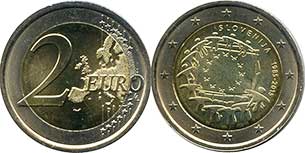
2 euro 2015
bi-metallic - nickel-brass/copper-nickel
commemorative coin
30th anniversary of the EU flag
2 EURO
SLOVENIJA / 1985-2015
Coin value ~ 4-6 USD
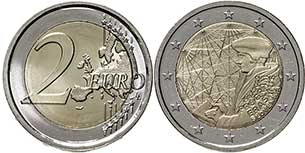
2 euro 2022
bi-metallic - nickel-brass/copper-nickel
commemorative coin
35 years of the Erasmus Programme
2 EURO
1987-2022 PROGRAM ERASMUS SLOVENIJA
Coin value ~ 3-4 USD
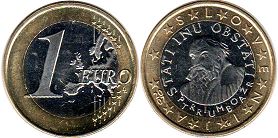
1 euro 2007 (2007- )
bi-metallic - copper-nickel/nickel-brass
1 EURO
SLOVENIJA / STATI INU OBSTATI / PRIMOZ TRUBAR / 2007
Coin value ~ 2-3 USD
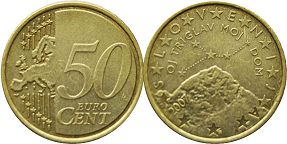
50 euro cent 2007 (2019- )
brass
50 EURO CENT
SLOVENIJA / OJ TRIGLAV MOJ DOM / 2007
Coin value ~ 2-3 USD
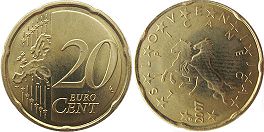
20 euro cent 2007 (2019- )
brass
20 EURO CENT
SLOVENIJA / LIPICANEC / 2007
Coin value ~ 1-2 USD
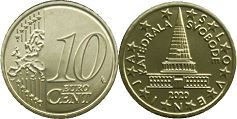
10 euro cent 2020 (2019- )
brass
10 EURO CENT
SLOVENIJA / KATEDRALA SVOBODE / 2020
Coin value ~ 1-2 USD
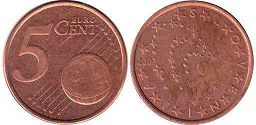
5 euro cent 2007 (2007- )
copper plated steel
5 EURO CENT
SLOVENIJA / 2007
Coin value < US$1
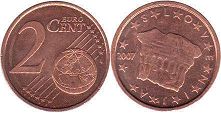
2 euro cent 2007 (2007- )
copper plated steel
2 EURO CENT
SLOVENIJA / 2007
Coin value < US$1

1 euro cent 2007 (2007- )
copper plated steel
1 EURO CENT
SLOVENIJA / 2007
Coin value < US$1
Commemorative euro coins of Slovenia
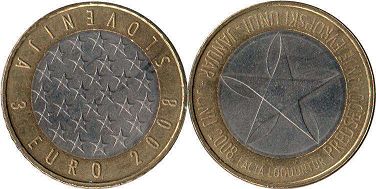
3 euro 2008
bi-metallic - copper-nickel/nickel-brass
Slovenian Presidency of the EU
3 EURO 2008 / SLOVENIJA / Field of stars representing EU membership
PREDSEDOVANJE EVROPSKI UNIJI - JANUAR - JUNIJ 2008 FACTA LOQUUNTUR / Pinwheel
Coin value ~ 5-7 USD
Euro coins of other countries
AndorraAustria
Belgium
Croatia
Cyprus
Estonia
Finland
France
Germany
Greece
Italy
Ireland
Latvia
Lithuania
Luxembourg
Malta
Monaco
Netherlands
Portugal
San Marino
Slovakia
Spain
Vatican
Costs of Slovenia euro coins in this catalog approximate and indicated specifically for the coin shown in the picture.
I do not buy or sell coins - this is just a catalog.

